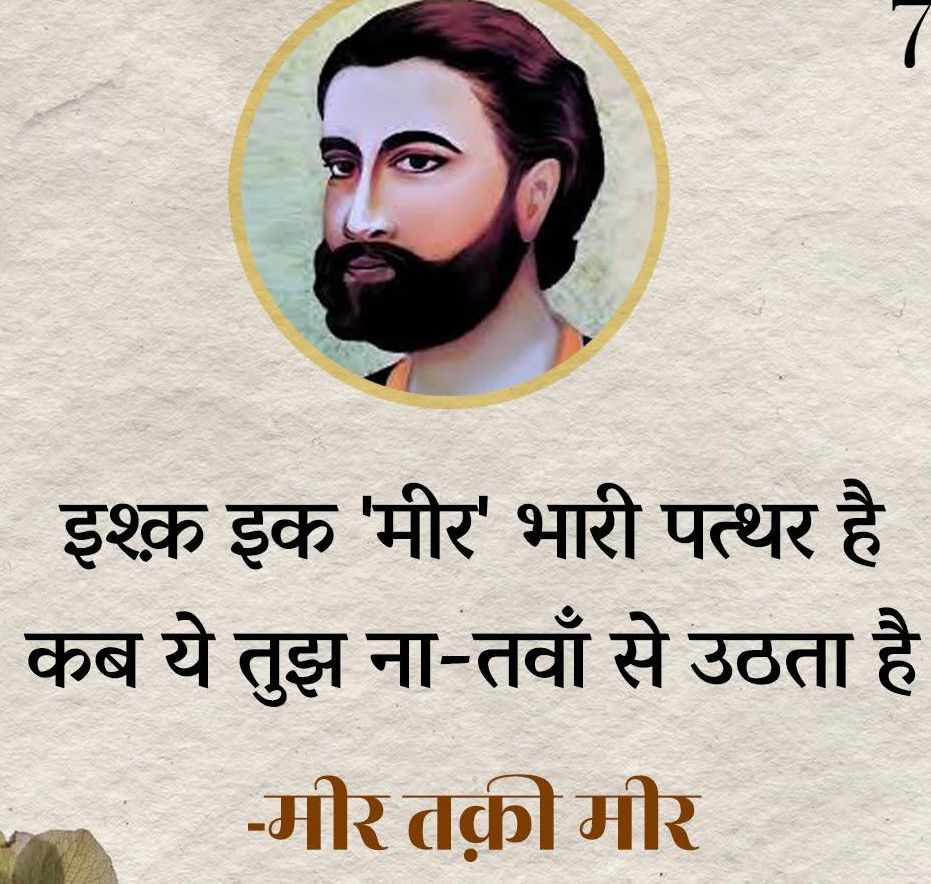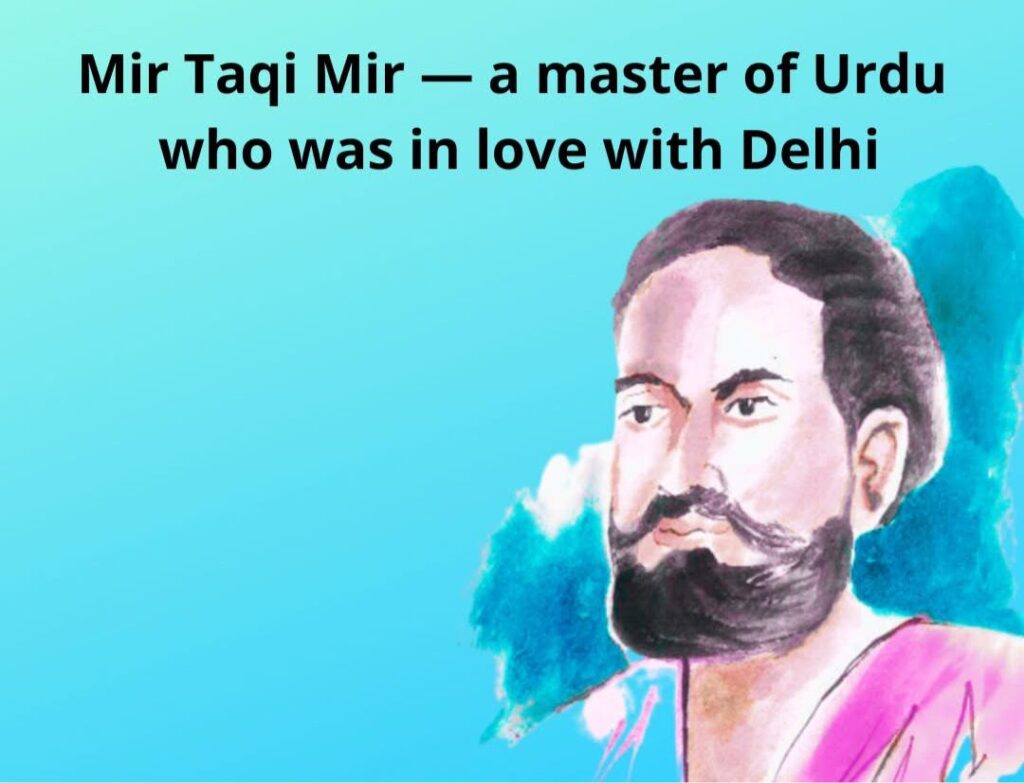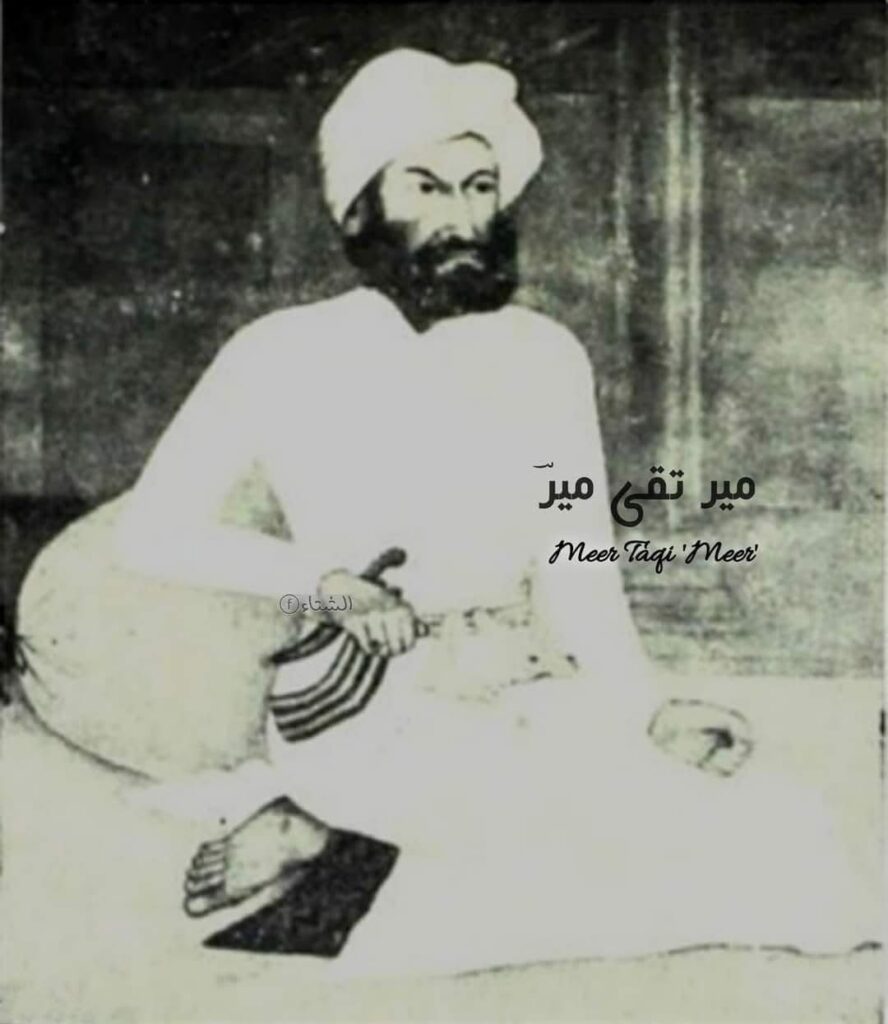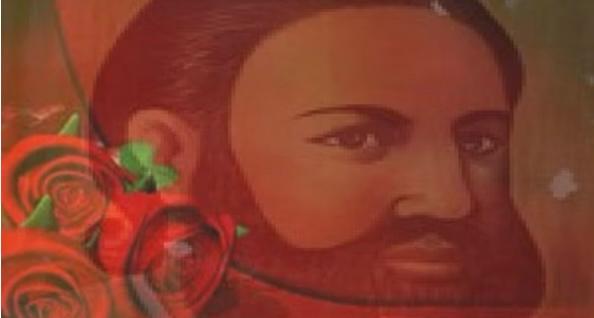

Patta Patta Boota Boota Haal Hamaara Jaane Hai”:
On the 215th Death Anniversary of Khuda-e-Sukhan, Mir Taqi Mir
“Mir ke deen-o-mazhab ka poonchte kya ho un nay to
“kashka khaincha dair mein baitha kab ka tark Islam kiya”
Every leaf, every stone, every sigh in the air of Hindustan seems to know the woe and wonder that was Mir Taqi Mir.
Two hundred and fifteen years since his passing on this day—20th September 1810—the lord of Urdu poetry stands, not merely as a figure in history, but as the very pulse and memory of the language itself. He who carried “habab ki si”—the foam-like frailty of existence—within his verses, remains immortal, more present than most who walk this earth.
“Mir dariya hai, suney sheyr zabaani uski
Allah Allah re tabiyat ki rawani uski”
A river, Mir was—a river of words that poured now as anguish, now as drunken rapture, always carrying a lingering music.

Born Mir Muhammad Taqi in 1723 Agra—the scion of Persianate Sufi ancestry, Scholar, orphan, lost child of a crumbling Mughal world—he crossed into Delhi at eleven, a city soon to be scarred by famine, invasion, and repeated sackings.
In Delhi he sought patronage, found poetry, and left behind a lifelong trail of grief and brilliance. The city shaped him as he, in turn, gave shape to its language before the loss of the metropolis to Ahmad Shah Abdali rendered Mir a poignant exile, seeking solace and poetic kinship in Lucknow.
“Gor kis diljale ki hai ye falak?
Shola ek subah yahan se uthta hai…”
Ah, what a graveyard was his cosmos—of lost hopes, of kin gone too soon, of cities drowned in the howl of time. Through sorrow, Mir’s “zabaan”—his tongue—broke forth like new rain: his was the music that founded the canonical form of the Urdu ghazal, weaving Hindustani sorrow with the grandeur of Persian idiom so deftly that it birthed a language to hold the spirit of two civilizations. He was one of the principal poets of the Delhi school, a master of the classical ghazal who could conjure with equal ease the delicate rubai, the playful satire, and the sweeping masnavi.
“Hasti apni habab ki si hai
Yeh numaish ik saraab ki si hai”
Mir’s genius was in the mellow music of sadness, in his ability to distil pain into poetry—this transformation elevating “hasti”—existence—into something sublime and universal. His works, collected in six divans comprising over 13,500 couplets, chart a journey through the stages of love, loss, and longing: his “Mu’amlat-e-Ishq” remains the high-water mark of romantic narrative in Urdu literature. Pathos was his essential note; yet, even as he sang of “ashk aankhon mein kab nahin aata”—eyes forever brimming with tears—Mir’s poetic lexicon expanded, embroidered, and fortified the very language he mourned in.
“Bekhudi le gai kahan humko,
Der se intezaar hai apna’”
Personal suffering shadowed Mir all his days. Tragedy—familial and civilizational—was etched into his lines. The deaths of his loved ones, his sensitive soul wounded by a rootless existence, led Mir to gifts of extraordinary empathy. In his introspection, lovers for centuries have found their own reflection, and in his melancholy, their solace. “What heart-sick sufferer’s grave is the sky?” he cried—each word the condensation of a universe in tears.
“Rekhta ke tum hi ustad nahin ho Ghalib
Kehte hain agle zamane mein koi Mir bhi tha”
To celebrate Mir is also to remember the timeless rivalry, the dialogue across the centuries with his poetic descendant, Mirza Ghalib.
It is no minor claim that even Ghalib, forever debated as the only equal, acknowledged Mir as his master. “He that vows not on Mir, is himself unlearned!” wrote Ghalib—attesting that the foundation of the ghazal is “dariya”—a river—whose headwaters are Mir himself.
Scholars from Gopi Chand Narang to Shamsur Rahman Faruqi have poured over this inheritance, finding in Mir an originality and “mood”—a unique atmosphere—rare even in the delicate latticework of Urdu verse. ‘
As Faruqi observed, where Ghalib soars, Mir roots; where Ghalib abstracts, Mir enfleshes, but in range and creative energy, Mir is the “Khuda-e-Sukhan”—the God of Poetry—alone.
“Patta patta boota boota haal hamara jaane hai
Jaane na jaane gul hi na jaane bagh to saara jaane hai”
Yet what remains truly revolutionary in Mir’s poetry is its empathy—the universality of his sorrow, whereby every leaf, every root, every anonymous mourner in the garden of existence becomes both confidant and witness. He employed a language that was at once sophisticated and full of immediate feeling—a wedding of Persian opulence with the simple, lived rhythms of Hindustani speech, immortalizing the speech of commoners and kings alike.
He was, as several recent exhibitions and digitisation projects have proved, a poet painstakingly preserved by his aficionados. From rare manuscripts in Rampur and Aligarh to virtual symposiums that traverse borders, Mir’s verses pulse through time, kept alive by scholars, enthusiasts, and lovers of Urdu.
“Dikhaai diye yun ki bekhud kiya
Hamein aap se bhi juda kar chale”
It is in lines like these that Mir’s art glimmers—where the presence of the beloved, the absence of the self, and the vast aching separation that lies in between become one.
So potent is his verse that it renders the reader “bekhud”—lost to self and time, suspended in the mystery and melancholy of yearning.
“Ibtidaa-e-ishq hai rotaa hai kyaa,
Aage aage dekhiye hotaa hai kyaa”
Mir’s lessons for today are manifold. He stands for the poet’s enduring role as conscience-keeper and rememberer; for faith beyond forms (as in the verse with the temple’s tilak and the abandoned orthodoxy); and for the resilience of language, able to endure even when cities and civilizations collapse.
In an age hungry for easy answers, Mir’s world is ambiguous, tragic, and beautifully unfinished—advising patience in love, and in life.
“Baad marne ke meri qabr pe aaya wo ‘Mir’
Yaad aayi mere Isa ko dawa mere baad”
In the end, Mir’s greatest magic is how, two centuries on, fresh tributes still ring out, poets gather in his name, digital archives extend his reach, and the world’s garden still knows the ache of his heart.
On this 215th death anniversary, the “khuda-e-sukhan” is not mourned, but revered and renewed—living on, as long as there are “patta patta”—leaves—and “boota boota”—shoots—to listen and tremble at his song.
Let the world note: the river of poetry that is Mir, still flows.

“nazuki uske lab ki kya kahiye
pankhudi ik gulab ki si hai”
And so, as soft as the petal of a rose, his words whisper still, carrying the fragrance of centuries, the pangs of love, and the resilience of an undying art.
On this day, the sky bends lower over Lucknow, Delhi, and the winding lanes of Agra. Poets remember. Lovers weep. Mir, eternal, walks in language. The garden knows. The heart remembers.
* “Patta patta boota boota haal hamara jaane hai.”
* Today, the garden—and the world—remembers Mir Taqi Mir.
Hasnain Naqvi is a former member of the history faculty at St. Xavier’s College, Mumbai


